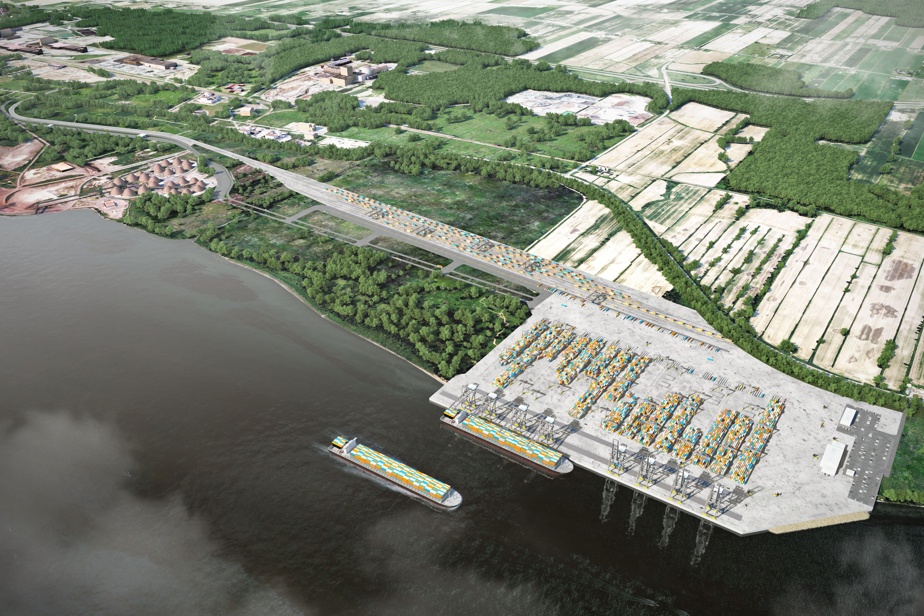(Montreal and Ottawa) Inflation plays a spoilsport role in Contrecœur’s financial set-up. The initial invoice no longer holds and the Montreal Port Authority (MPA) is stamping its feet while waiting for the Trudeau government. A sum of around 150 million is at the heart of the negotiations, according to our information.
According to the promoter – who has just received an additional 75 million from Quebec – an agreement must be reached by the end of the month so that the project can be set in motion towards the end of the year, as planned.
“The schedule must be maintained because in 2027, we will reach capacity,” said the President and CEO of the MPA, Martin Imbleau, on the sidelines of his appearance before the Board of Trade of Metropolitan Montreal (CCMM ), Tuesday.
He refused to advance on the sums claimed, saying he did not want to negotiate in the public square. He would not say why the negotiations are stretching. In front of an audience of business people, the head of the federal agency showed signs of impatience a few times. Negotiations with Ottawa “have been going on for quite a while,” he said.
The Contrecœur project, which is to see the light of day in the suburbs of Montreal, will cost more than the estimate ranging from 750 to 950 million previously mentioned. Mr. Imbleau would not put a number on the order of cost overruns, which he blames on inflationary pressures. Along with the funding, the MPA is still waiting for the green light from the federal government to encroach on the critical habitat of the copper redhorse, a fish threatened with extinction.
By releasing a new envelope in its budget tabled last month, the Legault government supports the project to the tune of 130 million. The Canada Infrastructure Bank (CIB) is also to offer $300 million in loans. The MPA and its private partner – which should be selected during the summer – will complete the financial package.
Financial support from the Trudeau government, combined with the additional effort from Quebec, would absorb the effects of inflation, according to Mr. Imbleau.
The Contrecoeur terminal should be able to handle 1.15 million “twenty-foot equivalent” (TEU) containers annually. The Port of Montreal can accommodate up to approximately 2 million metal boxes. Despite a decrease in tonnage of around 4% in January and February, the expansion of the Port of Montreal’s activities remains relevant, underlines the President of the MPA.
As recently as last October, a national supply chain task force pointed out that the transportation supply chain was approaching its breaking point in the country. The document was handed over to Federal Transport Minister Omar Alghabra.
Jean-Paul Rodrigue, maritime transport expert and professor at Hofstra University in New York, finds it hard to understand the Trudeau government’s reluctance.
“There are now inflation constraints,” says the expert, who is in favor of the Contrecœur terminal. It’s a shame, we could have afforded a less expensive project four or five years ago. This is one of the prices to pay. »
Mr. Rodrigue is adamant: without a new terminal, the Port of Montreal is doomed to see its long-term competitiveness eroded. In his opinion, the Contrecœur project constitutes an “exit door” in order to circumvent issues such as access to the Port of Montreal, which is becoming more and more complicated for trucks.
The budget tabled last week by Federal Minister Chrystia Freeland made no provision for the expansion of activities at the Port of Montreal. Ottawa also has another tool at its disposal: the National Trade Corridors Fund (NTCF).
With a budget of 4.7 billion, the initiative should make it possible to finance infrastructure projects, particularly in ports, in order to “improve the movement of goods and people”. Transport Canada issued seven calls for proposals. It was not possible to get an idea of the funds available in the NTCF.
“Where the funds come from is none of our business,” says Imbleau. Quebec opted for the budget. Obviously, the federal government is considering another option. »
Mr. Imbleau’s appearance before the CCMM comes two days before the visit of Ms. Freeland, who will be welcomed this Thursday by the business gallery. The president and head of the CCMM, Michel Leblanc, hinted that he could raise the issue of the Contrecœur project with the country’s great silversmith.
In an emailed statement, Valérie Glazer, spokesperson for Minister Alghabra, noted that the Trudeau government has already released $8 million to improve CanEst Transit infrastructure at the Port of Montreal. Added to this is the contribution of the CIB, she added.
Once the MPA has chosen its partner in the Contrecœur file, the time will come to consider the question of the protection of the Copper Knight. The Trudeau government has protected part of the habitat of this fish, on which the site partially encroaches.
The challenge for the Port of Montreal is to obtain a permit from Fisheries and Oceans Canada under the Species at Risk Act. This only provides for three exceptions to intervene in an officially designated critical habitat.
When questioned, the President of the Administration reiterated his confidence in the “compensation measures” developed. He expects to get the necessary clearances “sometime this year.”
